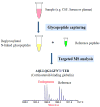Glycoproteomics in neurodegenerative diseases
- PMID: 19358229
- PMCID: PMC2799547
- DOI: 10.1002/mas.20221
Glycoproteomics in neurodegenerative diseases
Abstract
Protein glycosylation regulates protein function and cellular distribution. Additionally, aberrant protein glycosylations have been recognized to play major roles in human disorders, including neurodegenerative diseases. Glycoproteomics, a branch of proteomics that catalogs and quantifies glycoproteins, provides a powerful means to systematically profile the glycopeptides or glycoproteins of a complex mixture that are highly enriched in body fluids, and therefore, carry great potential to be diagnostic and/or prognostic markers. Application of this mass spectrometry-based technology to the study of neurodegenerative disorders (e.g., Alzheimer's disease and Parkinson's disease) is relatively new, and is expected to provide insight into the biochemical pathogenesis of neurodegeneration, as well as biomarker discovery. In this review, we have summarized the current understanding of glycoproteins in biology and neurodegenerative disease, and have discussed existing proteomic technologies that are utilized to characterize glycoproteins. Some of the ongoing studies, where glycoproteins isolated from cerebrospinal fluid and human brain are being characterized in Parkinson's disease at different stages versus controls, are presented, along with future applications of targeted validation of brain specific glycoproteins in body fluids.
Copyright 2009 Wiley Periodicals, Inc.
Figures



References
-
- Aarsland D, Andersen K, Larsen JP, Lolk A, Kragh-Sorensen P. Prevalence and characteristics of dementia in Parkinson disease: an 8-year prospective study. Arch Neurol. 2003;60:387–392. - PubMed
-
- Aarsland D, Andersen K, Larsen JP, Lolk A, Nielsen H, Kragh-Sorensen P. Risk of dementia in Parkinson's disease: a community-based, prospective study. Neurology. 2001;56:730–736. - PubMed
-
- Aarsland D, Larsen JP, Karlsen K, Lim NG, Tandberg E. Mental symptoms in Parkinson's disease are important contributors to caregiver distress. Int J Geriatr Psychiatry. 1999;14:866–874. - PubMed
-
- Abdi F, Quinn JF, Jankovic J, McIntosh M, Leverenz JB, Peskind E, Nixon R, Nutt J, Chung K, Zabetian C, Samii A, Lin M, Hattan S, Pan C, Wang Y, Jin J, Zhu D, Li GJ, Liu Y, Waichunas D, Montine TJ, Zhang J. Detection of biomarkers with a multiplex quantitative proteomic platform in cerebrospinal fluid of patients with neurodegenerative disorders. J Alzheimers Dis. 2006;9:293–348. - PubMed
-
- Aebersold R. Constellations in a cellular universe. Nature. 2003;422:115–116. - PubMed
Publication types
MeSH terms
Substances
Grants and funding
- ES012703/ES/NIEHS NIH HHS/United States
- R01 AG025327/AG/NIA NIH HHS/United States
- P50 AG008671/AG/NIA NIH HHS/United States
- NS057567/NS/NINDS NIH HHS/United States
- R01 AG033398/AG/NIA NIH HHS/United States
- AG05136/AG/NIA NIH HHS/United States
- NS060252/NS/NINDS NIH HHS/United States
- R01 ES012703/ES/NIEHS NIH HHS/United States
- AG033398/AG/NIA NIH HHS/United States
- R01 NS057567/NS/NINDS NIH HHS/United States
- AG08671/AG/NIA NIH HHS/United States
- R21 NS060252/NS/NINDS NIH HHS/United States
- P50 AG005136/AG/NIA NIH HHS/United States
- AG025327/AG/NIA NIH HHS/United States
LinkOut - more resources
Full Text Sources
Other Literature Sources
Medical

